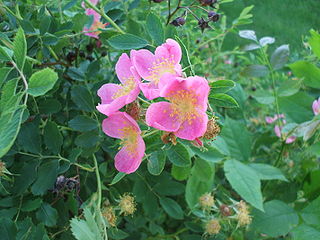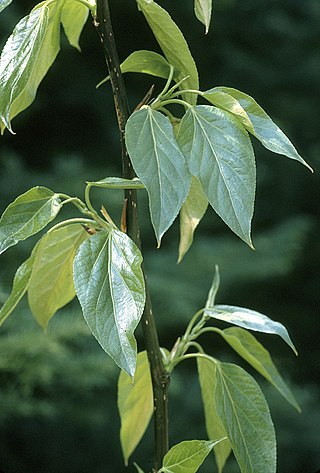
The United States Department of Agriculture (USDA) is an executive department of the United States federal government that aims to meet the needs of commercial farming and livestock food production, promotes agricultural trade and production, works to assure food safety, protects natural resources, fosters rural communities and works to end hunger in the United States and internationally. It is headed by the secretary of agriculture, who reports directly to the president of the United States and is a member of the president's Cabinet. The current secretary is Tom Vilsack, who has served since February 24, 2021.

Penstemon, the beardtongues, is a large genus of roughly 280 species of flowering plants native mostly to the Nearctic, but with a few species also found in the North American portion of the Neotropics. It is the largest genus of flowering plants endemic to North America. As well as being the scientific name, penstemon is also widely used as a common name for all Penstemon species alongside beardtongues.

The Agricultural Research Service (ARS) is the principal in-house research agency of the United States Department of Agriculture (USDA). ARS is one of four agencies in USDA's Research, Education and Economics mission area. ARS is charged with extending the nation's scientific knowledge and solving agricultural problems through its four national program areas: nutrition, food safety and quality; animal production and protection; natural resources and sustainable agricultural systems; and crop production and protection. ARS research focuses on solving problems affecting Americans every day. The ARS Headquarters is located in the Jamie L. Whitten Building on Independence Avenue in Washington, D.C., and the headquarters staff is located at the George Washington Carver Center (GWCC) in Beltsville, Maryland. For 2018, its budget was $1.2 billion.

Botrychium is a genus of ferns, seedless vascular plants in the family Ophioglossaceae. Botrychium species are known as moonworts. They are small, with fleshy roots, and reproduce by spores shed into the air. One part of the leaf, the trophophore, is sterile and fernlike; the other, the sporophore, is fertile and carries the clusters of sporangia or spore cases. Some species only occasionally emerge above ground and gain most of their nourishment from an association with mycorrhizal fungi.

Pinus echinata, the shortleaf pine, is a species of pine native to the Southeastern United States and Midwestern United States.

Pinus ponderosa, commonly known as the ponderosa pine, bull pine, blackjack pine, western yellow-pine, or filipinus pine is a very large pine tree species of variable habitat native to mountainous regions of western North America. It is the most widely distributed pine species in North America.
Natural Resources Conservation Service (NRCS), formerly known as the Soil Conservation Service (SCS), is an agency of the United States Department of Agriculture (USDA) that provides technical assistance to farmers and other private landowners and managers.

Bellis perennis, the daisy, is a European species of the family Asteraceae, often considered the archetypal species of the name daisy. To distinguish this species from other plants known as daisies, it is sometimes qualified as common daisy, lawn daisy or English daisy.

Rosa arkansana, the prairie rose or wild prairie rose, is a species of rose native to a large area of central North America, between the Appalachian and Rocky Mountains from Alberta, Manitoba, and Saskatchewan south to New Mexico, Texas and Indiana. There are two varieties:
A hardiness zone is a geographic area defined as having a certain average annual minimum temperature, a factor relevant to the survival of many plants. In some systems other statistics are included in the calculations. The original and most widely used system, developed by the United States Department of Agriculture (USDA) as a rough guide for landscaping and gardening, defines 13 zones by long-term average annual extreme minimum temperatures. It has been adapted by and to other countries in various forms.

Taxodium distichum is a deciduous conifer in the family Cupressaceae. It is native to the southeastern United States. Hardy and tough, this tree adapts to a wide range of soil types, whether wet, salty, dry, or swampy. It is noted for the russet-red fall color of its lacy needles.

Grindelia squarrosa, also known as a curly-top gumweed or curlycup gumweed, is a small North American biennial or short-lived perennial plant.

Monarda fistulosa, the wild bergamot or bee balm, is a wildflower in the mint family Lamiaceae, widespread and abundant as a native plant in much of North America. This plant, with showy summer-blooming pink to lavender flowers, is often used as a honey plant, medicinal plant, and garden ornamental. The species is quite variable, and several subspecies or varieties have been recognized within it.

Populus balsamifera, commonly called balsam poplar, bam, bamtree, eastern balsam-poplar, hackmatack, tacamahac poplar, tacamahaca, is a tree species in the balsam poplar species group in the poplar genus, Populus. The genus name Populus is from the Latin for poplar, and the specific epithet balsamifera from Latin for "balsam-bearing".
Blutaparon rigidum, sometimes known as the Galapagos amaranth, was a species of plant in the family Amaranthaceae. It was endemic to the Galápagos Islands in Ecuador.

Lycopodiella inundata is a species of club moss known by the common names inundated club moss, marsh clubmoss and northern bog club moss. It has a circumpolar and circumboreal distribution, occurring throughout the northern Northern Hemisphere from the Arctic to montane temperate regions in Eurasia and North America. It grows in wet habitat, such as bogs, ponds, moist spots on the tundra, and long-standing borrow pits.

Vermiculation is a surface pattern of dense but irregular lines, so called from the Latin vermiculus meaning "little worm" because the shapes resemble worms, worm-casts, or worm tracks in mud or wet sand. The word may be used in a number of contexts for patterns that have little in common. The adjective vermiculated is more often used than the noun.

Artemisia cana is a species of sagebrush native to western and central North America; it is a member of the sunflower family. It is known by many common names, including silver sagebrush, sticky sagebrush, silver wormwood, hoary sagebrush, and dwarf sagebrush.















